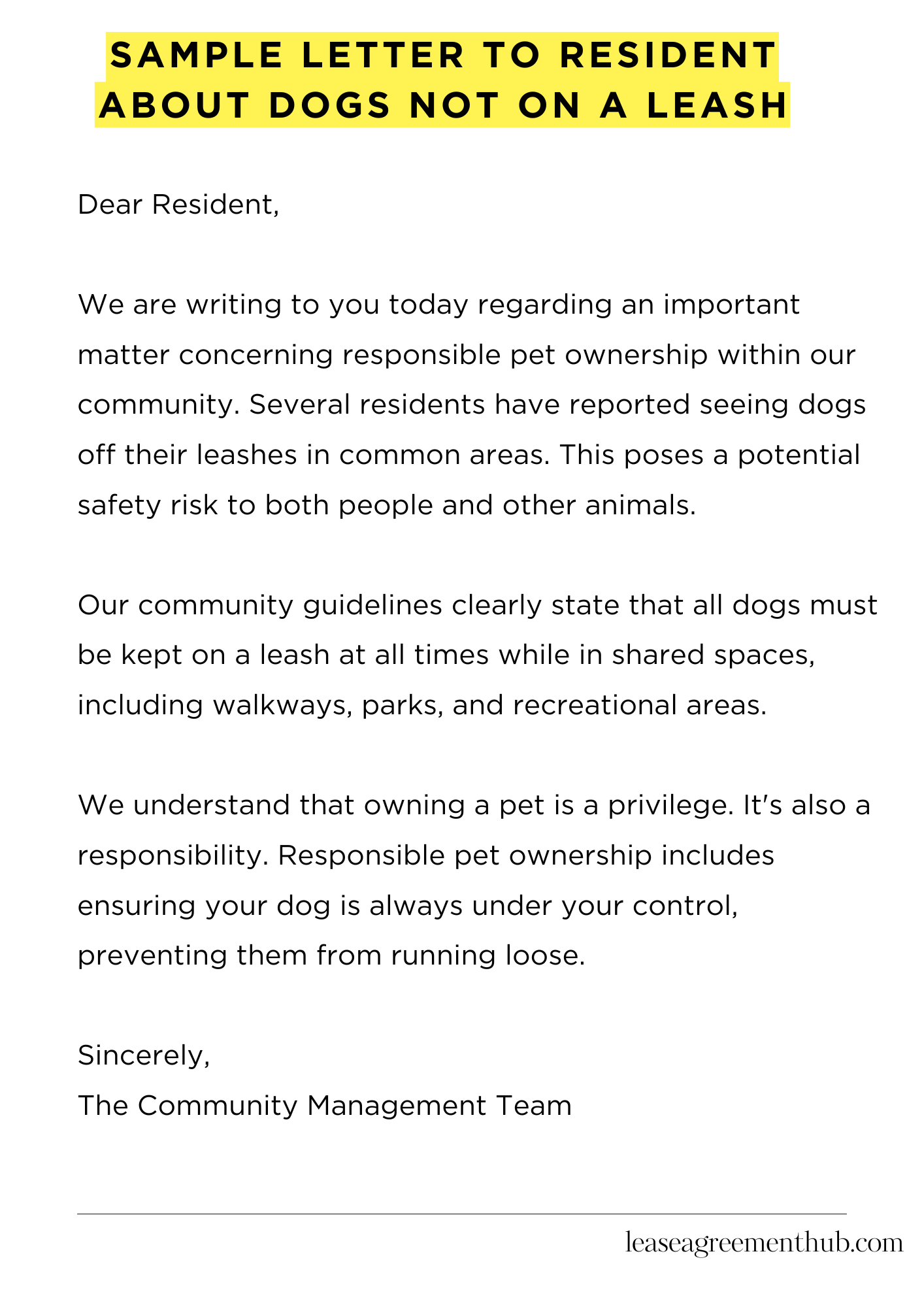This article provides sample letters. The letters address the issue of unleashed dogs. They’re for residents who need to address this problem.
We’ll give you several letter templates. These examples make writing easier. You can adapt them to your specific situation.
Use these samples to write your own letter. They’ll help you communicate clearly and effectively.
Sample Letter to Resident About Dogs Not on Leash
October 26, 2023
Dear Resident,
We are writing to you today regarding an important matter concerning responsible pet ownership within our community. Several residents have reported seeing dogs off their leashes in common areas. This poses a potential safety risk to both people and other animals.
Our community guidelines clearly state that all dogs must be kept on a leash at all times while in shared spaces, including walkways, parks, and recreational areas. This is crucial for maintaining a safe and harmonious environment for everyone. Unleashed dogs can be unpredictable, leading to accidents or frightening encounters.
We understand that owning a pet is a privilege. It’s also a responsibility. Responsible pet ownership includes ensuring your dog is always under your control, preventing them from running loose. Please ensure your dog is always securely leashed when outside your home.
Failure to comply with our community guidelines regarding leash laws may result in further action. We value your cooperation in maintaining a safe and enjoyable community for all.
Sincerely,
The Community Management Team

How to Write a Sample Letter to Residents About Dogs Not on Leashes
Understanding the Nuances of Epistolary Persuasion
Crafting an effective letter necessitates a nuanced understanding of your audience. Residents are diverse; some may be amenable to polite requests, while others require a more forceful approach. Therefore, strike a balance between amicable discourse and assertive clarity. Your goal is not to incite but to inform and motivate compliance. Consider the overall tone; a conciliatory approach is often better than a combative one, even when addressing egregious violations.
Defining the Problem: A Concise and Persuasive Opening
Begin by stating the problem succinctly. Avoid circumlocution. For instance, instead of meandering, directly address the issue of unleashed dogs. Employ strong verbs and concrete examples. A compelling opening will immediately grab the reader’s attention and establish the letter’s gravitas. Phrases such as “increasing instances of” or “a concerning upsurge in” immediately establish the seriousness of the situation.
Highlighting the Risks: Eloquence in Explaining Consequences
Clearly articulate the potential dangers posed by unleashed canines. This section should not be emotionally charged but factually robust. Mention potential injuries to children, other pets, or even adults. Reference local ordinances or homeowner’s association rules to bolster your argument. This section requires judicious use of evidence-based assertions. Using concrete examples helps resonate better than generalizations.
Proposing Solutions: A Constructive and Collaborative Approach
Don’t simply point out the problem; offer viable solutions. Suggest dog-walking etiquette reminders, perhaps posting signage, or organizing community events that promote responsible pet ownership. A collaborative tone fosters a sense of shared responsibility, making residents more receptive to your message. Frame the suggestions as beneficial improvements for the entire community, rather than solely as restrictions.
Maintaining a Professional and Respectful Tone: The Art of Diplomatic Language
Throughout the letter, maintain a professional and courteous demeanor. Refrain from accusatory language or inflammatory rhetoric. Using passive voice can often soften the tone without sacrificing clarity. Your goal is to persuade, not to antagonize. Remember, even when dealing with egregious violations, a polite, respectful tone is more likely to achieve your objective.
Call to Action: A Clear and Concise Directive
Conclude with a clear and concise call to action. Request residents to comply with leash laws, attend a community meeting (if applicable), or contact a specific individual with questions or concerns. Provide contact information for further inquiries. This section should be unambiguous and leave no room for misinterpretation.
Proofreading and Dissemination: The Final Steps to Success
Before sending, meticulously proofread your letter. Errors undermine credibility. Choose an appropriate dissemination method: email, physical mail, or a combination thereof, depending on your audience and resources. Ensuring wide dissemination is crucial for the success of your initiative. A well-crafted and widely distributed letter can dramatically improve leash compliance within your community.
FAQs about sample letter to resident about dogs not on a leash
What is the purpose of writing a letter to a resident about their unleashed dog?
The purpose is to politely but firmly address the issue of an unleashed dog, highlighting the potential safety hazards and violations of community rules or local ordinances. The letter aims to encourage responsible pet ownership and prevent future incidents.
What information should be included in the letter?
The letter should clearly state the observed incident (date, time, location), describe the dog’s behavior, and explain why it’s a concern (e.g., safety of children, other pets, or community rules). It should also politely request the resident to keep their dog leashed in the future and possibly refer to relevant regulations or community guidelines.
What tone should the letter adopt?
The letter should maintain a polite and professional tone, avoiding accusatory or confrontational language. A respectful approach is more likely to encourage cooperation and compliance. Focus on the issue, not on personal attacks.
What if the resident is unresponsive or the problem persists after sending the letter?
If the resident doesn’t respond or the problem continues, further action may be necessary. This could involve contacting your homeowner’s association, local animal control, or other relevant authorities, depending on the severity of the issue and your community’s regulations.
Are there any legal considerations when writing such a letter?
Ensure the letter is factual and avoids making false accusations. It’s advisable to consult with your homeowner’s association or legal counsel to understand the relevant regulations and ensure the letter complies with local laws and community rules before sending it.
Related: